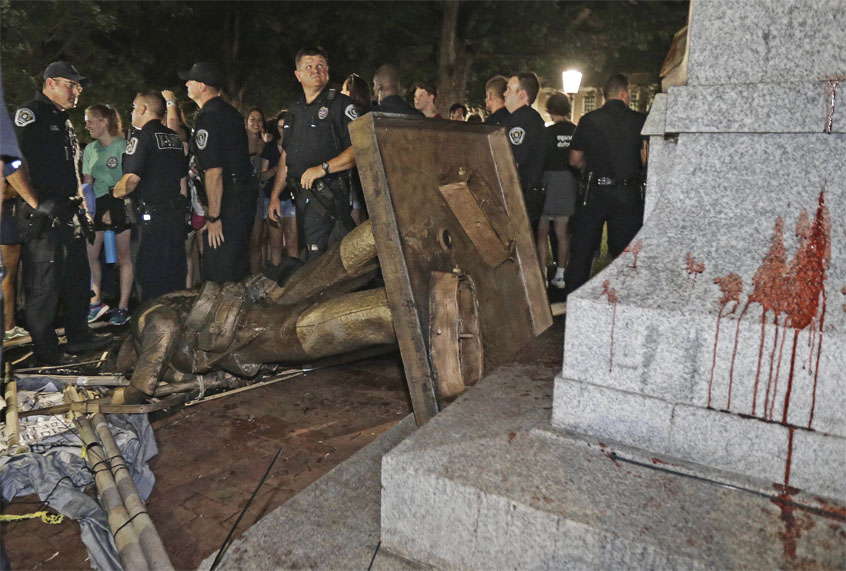Almost 80 teaching assistants are on a grade strike at the University of North Carolina at Chapel Hill (UNC), refusing to distribute their students’ final marks until the school abandons a proposed plan to construct a building to house an infamous Confederate monument. The strike is the columination of a year of protests against the racist symbol.
Silent Sam is a statue of a Confederate soldier that was erected on UNC’s campus in 1913 by a white-supremacist group called the United Daughters of the Confederacy. Its supporters claim that the statue is simply a tribute to soldiers. But, in fact, the statue was erected years after the Civil War ended, as a monument to the racial apartheid of the Jim Crow era.
Noted white supremacist and former UNC trustee Julian Carr gave a speech in 1913 at the initial dedication ceremony for Silent Sam, praising the racist violence that flourished after the war. “The present generation, I am persuaded, scarcely takes note of what the Confederate soldier meant to the welfare of the Anglo Saxon race during the four years immediately succeeding the war, when the facts are, that their courage and steadfastness saved the very life of the Anglo Saxon race in the South,” said Carr. He added, “today, as a consequence the purest strain of the Anglo Saxon is to be found in the 13 Southern States – Praise God.”
UNC students have been protesting the existence of the Silent Sam statue for the last 50 years. After Martin Luther King Jr. was assassinated in 1968, students threw paint on the monument and tagged it with graffiti. The monument was the site of numerous protests by the Black Student Movement during the 1970s, and in 1981 the monument was vandalized during the National Collegiate Athletic Association basketball finals.
On April 30 of this year, a graduate student in history, Maya Little, was arrested after painting Silent Sam red and dousing it with her own blood. Little released a statement explaining that she did this to help contextualize the statue and call out the school’s Chancellor Carol Folt for refusing to listen to protesters’ concerns. “We see the mutilation of black bodies, the degradation of black people, the celebration of an army that fought for our ancestors’ enslavement,” reads Little’s statement. “I see Julian Carr whipping a black woman. I see your willingness to traumatize, dehumanize, and endanger every black person on this campus. We see our blood and now you will too.”
In August, 250 protestors toppled Silent Sam while chanting, “We believe that we will win!”
The statue hasn’t been put back up since it was knocked down. But on December 3, UNC’s board and Chancellor Folt released a proposed plan to return Silent Sam to the campus: The monument would be put in a brand-new building that would cost $5 million to construct and $800,000 a year to keep up.
Up until recently, Samuel Finesurrey was a teaching assistant at UNC, and he is currently helping the striking staff. He has participated in the resistance to Silent Sam for over a year. “We have one demand,” he told In These Times. “Get rid of the proposal. We’re hoping the action embarrasses the university and they should be embarrassed.”
In response to the grade strike, the school’s Executive Vice Chancellor and Provost Bob Blouin sent an email throughout the campus accusing the teaching assistants of violating their students’ rights and claiming that the action is widely opposed. “The university has received student and parent complaints,” reads the email. “Such actions have been interpreted as coercion and an exploitation of the teacher-student relationship and in fact are a violation of students’ First Amendment rights as well as federal law.”
Finesurrey said that the majority of students and faculty are, in fact, against the building being constructed—and that Blouin’s perception of First Amendment rights was curious. “The building will be a rallying point for Nazis, and it would be built across the street from a synagogue,” he said. According to Finesurrey, the existence of Silent Sam on campus is a violation of the Civil Rights Act that prohibits black students from being subjected to a hostile environment.
Finesurrey said he doesn’t believe the school’s board is racist, but rather, they lack the motivation to act. “I don’t think they’re pro-confederate,” he said, “just cowards that want to hold onto their cushy jobs.”


